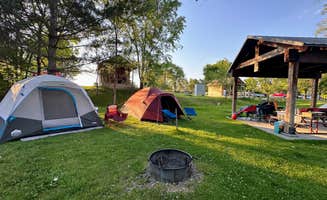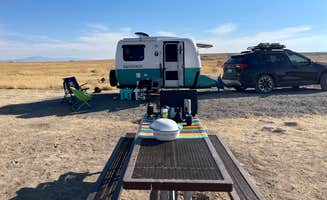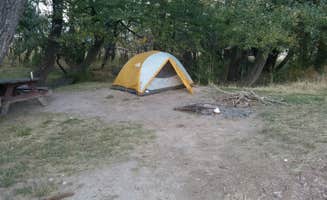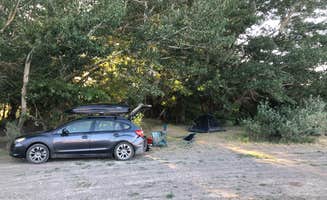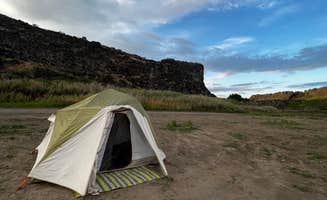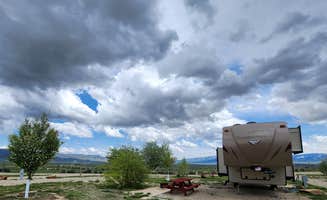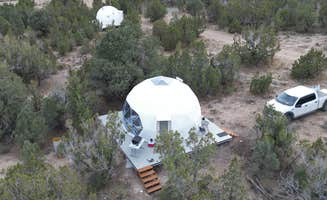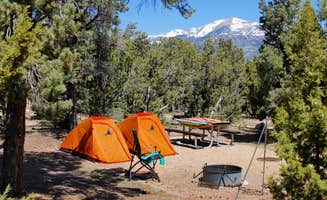Camping opportunities near Rupert, Idaho include approximately 10 established campgrounds within 30 miles, ranging from state parks to Bureau of Land Management dispersed areas. The region sits at elevations between 4,100-7,500 feet, with summer temperatures averaging 85-95°F in July and August. Camping conditions vary dramatically from the Snake River corridor with its established facilities to more remote high-desert camping requiring significant preparation for extreme temperature swings.
What to do
Disc golf at state parks: Massacre Rocks State Park Campground offers a full course on-site. A camper noted, "Bring your disc golf, your fishing pole, and your chair for the evenings! Quiet, restrooms and showers were clean."
Birdwatching along Snake River: Cauldron Linn BLM Dispersed provides excellent wildlife viewing opportunities. "Beautiful migration of myriad geese at night. Great hiking all around the Snake River offers serenity with dramatic rock formations and vegetation," reports a visitor.
Paddle sports on calm waters: Small lakes and reservoir sections offer flat-water paddling opportunities. At Milner Historic Recreation Area, "The river here is calm enough to paddle board on. We spent lots of time on the water and even paddled across to some rocks and did a little cliff jumping."
Oregon Trail history exploration: Several campgrounds provide access to historic sites. "We enjoyed the hike/walk out to the Oregon Trail wagon ruts," writes a camper at Massacre Rocks, where interpretive trails help visitors understand the area's significance.
What campers like
Riverside camping access: Village of Trees RV Resort sits directly on the Snake River with easy water access. A camper shares, "A short path leads to a public launch on the Snake River...the office is also a diner with breakfast and lunch. Order and have it delivered directly to your site."
Uncrowded fishing spots: Many campers mention successful fishing at multiple locations. One visitor to Cauldron Linn noted, "Great fishing, caught at least 4 fish a day while camping (small bass, there were several bigger fish but I didn't have the right lures)."
Budget-friendly options: Several campgrounds offer affordable rates. At Murtaugh Lake Park Campground, a camper was surprised at the value: "Can't believe tent spots are $5/night and RV with hookups is only $15."
Wildlife viewing opportunities: The region supports diverse wildlife populations. At Lake Walcott State Park Campground, "The park is a wild life refuge so we saw Deer and Racoons at night. We kept all food items in out car to avoid issues."
What you should know
Road conditions to remote sites: Some dispersed camping areas require careful vehicle selection. For Cauldron Linn, a camper warns, "Farm road to BLM awash with loads of potholes but can be navigated cautiously. Once at the Cauldron, do not go down to the river unless you have 4WD."
Seasonal insect considerations: Several campgrounds report periodic insect issues. One visitor to Lake Walcott noted, "This is not the place for those with Insect phobias. There were non stinging flying insects all up in our face and flying up our nose."
Agricultural impacts: Proximity to farmland affects some camping areas. At McClendon Spring Campground, visitors should expect "About 3 1/2 miles on a semi maintained gravel road. Lots of cows. Nice quiet spot with some picnic benches."
Water level fluctuations: Dam operations impact camping and recreation. "As we have seen with COEs, there's a dam between the lake and the river, so when they open or close the floodgates, there's a siren that goes off until the process is completed."
Tips for camping with families
Playgrounds and protected swimming: Several parks offer designated play areas for children. At Lake Walcott, "There was a pretty good park with play equipment for the kids during the midday hours."
Educational opportunities: History-focused campgrounds provide learning experiences. At Heyburn Riverside RV Park, a visitor appreciated "the city park and county visitor's center where there are very nice walking trails."
Cabin options for easier trips: Several campgrounds provide cabin accommodations. A Lake Walcott visitor mentioned, "If you don't have an RV, they have cabins that look very nice also."
Wildlife safety preparation: Families should prepare for wildlife encounters. "The park is a wild life refuge so we saw Deer and Racoons at night. We kept all food items in our car to avoid issues."
Tips from RVers
Advance planning for big rigs: Many sites accommodate larger rigs but require reservations. At Village of Trees RV Resort, an RVer reported, "Sites here are easy pull-thrus with full hookups. A nice little patch of grass spaces out RV's and gives each site its own outdoor space."
Hookup limitations: Not all campgrounds offer full hookups or dump stations. For Murtaugh Lake Park, a camper noted, "The downside is that there is no dump station. And no sewer connection. There are only pit toilets and no showers."
Satellite and cell coverage: Coverage varies significantly by location. An RVer at McClendon Spring observed, "We got 2 bars on Verizon. There are two tent areas, one that's to the first right with the day-use area and another that's adjacent to the RV CG and cabins."
Leveling considerations: Some campgrounds have uneven terrain. A camper at Murtaugh Lake Park warned, "The grounds are a little uneven at certain points with gopher holes, but every site has a nice fire pit and picnic area."


